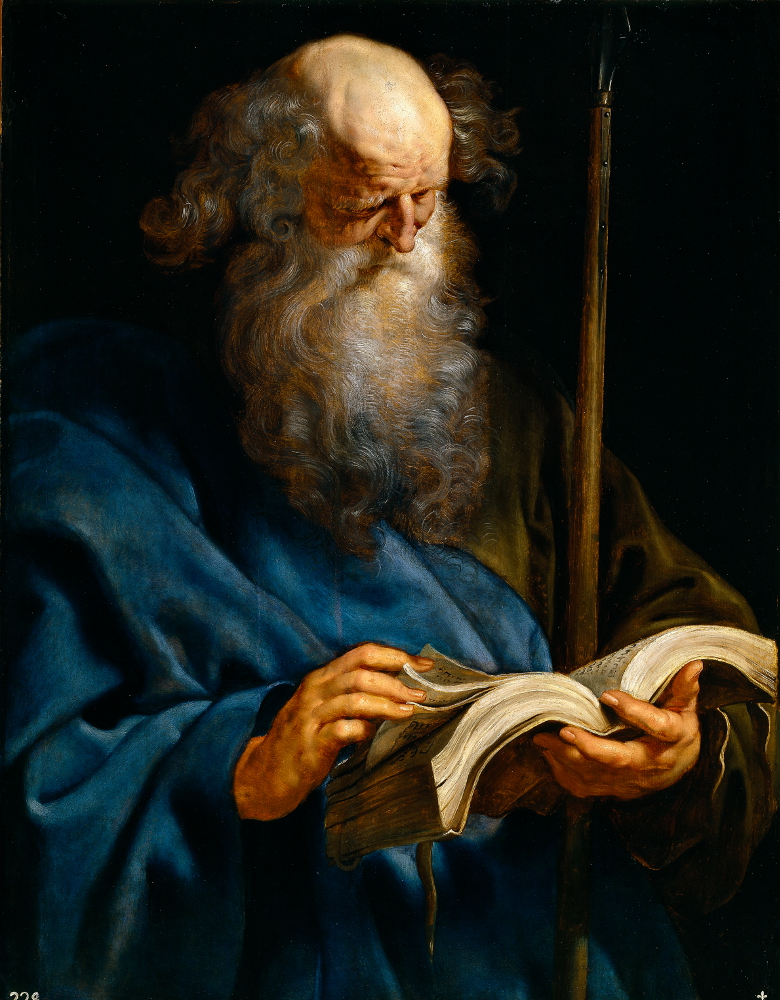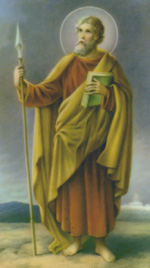
St. Thomas by Peter Paul Rubens…
Last week’s post was on Easter Season – AND BEYOND. This post discusses Doubting Thomases, including the “mother of all” such skeptics. See Thomas the Apostle – Wikipedia.
The Gospel-reading for Sunday, April 12, discusses the original Doubting Thomas. See Second Sunday of Easter and/or John 20:19-31. But first a word about the painting by Rubens, above:
Around 1612 Rubens made a series of portraits of the apostles, in commission of the duke of Lerma. All paintings show an attribute to identify the apostle. Thomas holds a spear, the weapon that supposedly killed him and made him a martyr.
(See Peter Paul Rubens: St Thomas – Art and the Bible. See also Acts of Thomas, written “as late as c. 200.”) Wikipedia noted the tradition that Thomas sailed to India in the year 52 AD, to spread the Christian faith, and included the “spear” details of his martydom:
According to tradition, St. Thomas was killed in 72 AD[, possibly] at Mylapore near Chennai in India… This is the earliest known record of his martyrdom.. Some Patristic literature state[s] that St. Thomas died a martyr, in east of Persia or in North India by the wounds of the four spears pierced into his body by the local soldiers.
As also noted last week, even to this day many people still don’t believe in the miraculous healing power of Jesus, let alone His resurrection from the dead. (Or as Isaac Asimov put it, to such people “the tale of the resurrection must be put down to legend.”) But Asimov also noted that if the story had ended with the burial of Jesus – without His Resurrection – it’s highly unlikely that the Christian faith would have grown over the centuries as it did:
…even if we take the rationalist view that there was no resurrection in reality, it cannot be denied that there was one in the belief of the disciples and, eventually, of hundreds of millions of men – and that made all the difference. (E.A.)
 In other words, if it hadn’t been for the millions upon millions of people who came to believe in the Resurrection of Jesus, “the history of the world would be ‘enormously different.'” See On Easter Season, which included the image at left. And there are of course some who would say the history of the world would have been better without the spread of the Christian faith.
In other words, if it hadn’t been for the millions upon millions of people who came to believe in the Resurrection of Jesus, “the history of the world would be ‘enormously different.'” See On Easter Season, which included the image at left. And there are of course some who would say the history of the world would have been better without the spread of the Christian faith.
Before addressing that issue, it can’t be denied that there are many examples – even today – of some ostensible followers of Jesus of whom it could be said, “The name of God is blasphemed among the Gentiles because of you.’” See Romans 2:24 (referring Isaiah 52:5).
And there’s also the key difference between “skeptical” and “cynical.” The difference is that being skeptical means “having reservations,” while the “main meaning of cynical is ‘believing the worst of people.” (Or, being “distrustful of human sincerity or integrity.”) On the other hand, the Bible itself tells us to approach the Faith with the proper sense of “reservation:”
Dear friends, do not believe every spirit, but test the spirits to see whether they are from God, because many false prophets have gone out into the world.
See 1st John 4:1, emphasis added. All of which adds up to this: It’s impossible to give a comprehensive answer to such Doubting Thomases in one post. But the best short answer might be that – taken as a whole – the Faith has led us in the direction of “believing the best of people.” (Or at least not being cynical so much, which is definitely a drag if not a bummer…)
That is, even some atheists admit that – taken as a whole – Christianity has had a positive influence on history. See Christianity’s Positive Contributions: An Atheist Confession:
Christianity is far more than just pie in the sky in the sweet bye and bye. Wherever Christian missionaries and workers have gone, there has been tremendous work in social reform. The Christian Gospel is not just about getting souls into heaven, but bettering conditions on planet earth as well.
Or just you could just Google “Christianity positive influence history.”
For other answers to such skeptics, see Mike Mooney’s post, Why I’d Still Believe In God Even if the Bible was a Fairytale. Or you could check out The True Test of Faith, noted above.
All of which brings us back to “the original Doubting Thomas.”
As Wikipedia noted, he was “informally called doubting Thomas because he doubted Jesus’ resurrection.” (I.e., when he first heard about it, as told “in the Gospel of John.”) But see Thomas the Apostle, which said if “Thomas was pessimistic, he was also sturdily loyal.”)
But Thomas’s original doubt was followed – a week later – by a confession of faith, “My Lord and my God,” on seeing Jesus’ wounded body. As noted in St. Thomas … AmericanCatholic.org:
Poor Thomas! He made one remark and has been branded as “Doubting Thomas” ever since. But if he doubted, he also believed. He made what is certainly the most explicit statement of faith in the New Testament: “My Lord and My God!” [See John 20:28] and, in so expressing his faith, gave Christians a prayer that will be said till the end of time.
The emphasized portion reveals the most important point about Thomas. He was – it might be said – the original “mother of all skeptics.” But like the Apostle Paul, his testimony was all the more believable, forceful and compelling precisely because he “started out on the other side.” See Was the Apostle Paul actually a false prophet:
Paul’s apostolic authority has been well documented in Scripture, beginning with his dramatic Damascus Road experience which changed him from a Christ-hating persecutor of Christians to the foremost spokesman for the faith. His astonishing change of heart is one of the clearest indications of his anointing by the Lord Jesus Himself. (E.A.)
(See also Galatians 1:13, where Paul said, “you have heard of my previous way of life in Judaism, how intensely I persecuted the church of God and tried to destroy it.”)
 Of course Paul’s Damascus Road Experience is the more widely known of the two, but like St. Thomas, he too went from being at least a skeptic to a firm believer. And as also noted above, Thomas gave arguably “the most explicit statement of faith in the New Testament.”
Of course Paul’s Damascus Road Experience is the more widely known of the two, but like St. Thomas, he too went from being at least a skeptic to a firm believer. And as also noted above, Thomas gave arguably “the most explicit statement of faith in the New Testament.”
Getting back to Thomas’s own Passage to India (alluding to the 1924 “novel by English author E. M. Forster“)… See for example St. Thomas – Saints & Angels – Catholic Online, which provided the image at right. It also noted that in his travels, Thomas “ultimately reached India, carrying the Faith to the Malabar coast, which still boasts a large native population calling themselves ‘Christians of St. Thomas.'”
For another view, see About Saint Thomas the Apostle. The site said after the Ascension of Jesus, the apostles decided who would go where for missionary purposes, and told Thomas to go to India. He objected, saying he wasn’t healthy enough for such travel, and that “a Hebrew couldn’t possibly teach the Indians.” But then, like St. Patrick, he became a literal slave:
A merchant eventually sold Thomas into slavery in India. It was then, when he was freed from bondage that this saint began to form Christian parishes and building churches. It’s not surprising that to this day, St. Thomas is especially venerated as The Apostle in India. According to legend, Thomas built a total of seven churches in India, as well as being martyred during a prayer session with a spear around the year 72 C.E [and is] upheld as an example of both doubter and a staunch and loyal believer in Christ… After all, each of us has both of these characteristics residing deep within ourselves – both moments of doubt and those of great spiritual strength…
And that – the post concluded – is why “we are so drawn to this historical Christian figure.”
Note also the end of the Gospel reading noted for April 12:
Now Jesus did many other signs in the presence of his disciples, which are not written in this book. But these are written so that you may come to believe that Jesus is the Messiah, the Son of God, and that through believing you may have life in his name.
Which is as good a way to end this post as any…

The “Martyrdom of St. Thomas by Peter Paul Rubens…”
The upper image is courtesy of Peter Paul Rubens: St Thomas – Art and the Bible.
Re: “drag” and “bummer.” The terms at issue – as popularized in the 1960s – are alternatively defined as “someone or something that is boring, annoying, or disappointing,” “someone or something that makes action or progress slower or more difficult,” or – vis-a-vis bummer – someone who “depresses, frustrates, or disappoints[, as in]: Getting stranded at the airport was a real bummer, or “an unpleasant or disappointing experience.” And in turn it cannot be denied that there are some among the Christian faith whose methods could be deemed a drag, a bummer, or both.
Re: John 20:28. The commentary added, “The disbelief of the apostle is the means of furnishing us with a full and satisfactory demonstration of the resurrection of our Lord.”
Re: Thomas becoming a literal slave “like St. Patrick.” See On St. Paddy and St. Joe.
The lower image is courtesy of Thomas the Apostle – Wikipedia.